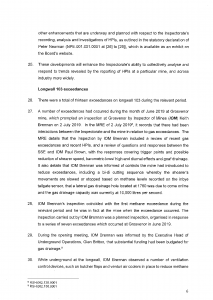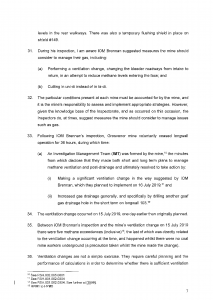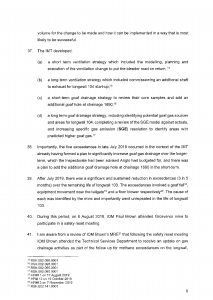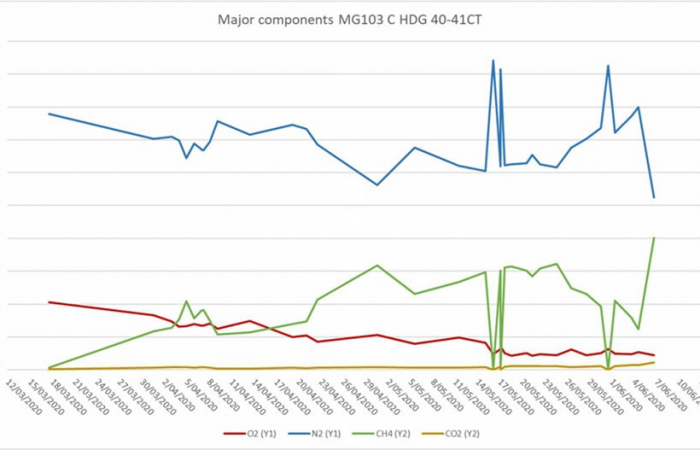
Grosvenor LW 104 Second Workings Notices to Mines Inspector S 320 Regulations. Were the Inspectors satisfied with the risk assessed outcomes for Substantial changes for Ventilation from LW 103?
The strategy to manage C heading as part of the Tailgate 104 return would have been supported by extensive documentation including a LW104 specific risk assessment.
This is to comply with Regulation 318) 2) The procedure must be based on the results of the risk assessment mentioned in section 317, and 3) The mine must have a separate procedure for each panel in the mine.
I do not have a Second Workings Notice for Grosvenor Mine. However I do have one for Oaky North Mine from 2014. (link below). It is 48 pages long without any of the Procedures and Hazard Management plans referenced or the underpinning risk assessments.
Oaky North_Second Workings SOP_SOP0318OCN LW404
One of the issues, as I will set out below, is that during LW 103 the decision is made to change the bleeder road from Intake to Return.
Under Regulations 318, 319 and 320 (copied at the end of this post), significant planned changes to the SOP concerning ventilation must be fully risk assessed prior to the SOP being altered and implemented; and the Inspector being provided with the new SOP (unless during an emergency).
The changed Ventilation Procedures would then have to be taken as the existing SOP’s for the Second Working Plans that the LW 104 risk assessment must assess change as well as the procedures provided in the notice to the Inspectors before LW 103 commenced.
According to Inspector Smiths statement, the Grosvenor Mine IMT decided when the ventilation in 103 was changed to an exhaust bleeder road to develop a long term ventilation strategy which included commissioning an additional shaft to exhaust for longwall 104 start up.
This raises a number of questions including but not limited to;
- Why did Grosvenor Management decide to have the additional shaft to exhaust for longwall 104 start up, revert to an intake bleeder ventilation shaft and roadway for the “Little Britton” Ventilation Arrangement?
- How did the risk assessment for LW 104 justify reverting to an intake shaft and bleeder road as NOT having an increased risk from the return bleeder system the Mine changed to in LW 103 to control methane migration to the tailgate?
- On what basis did the mine decide to that the use a forcing fan arrangement on the intake shaft and “bleeder road” was an acceptable level of risk to workers?
- Did the risk assessment identify that the very high differential pressures resulting in an INCREASED Risk of Spontaneous Combustion
- Given that the Grosvenor Mine Management had identified increased SGE (specific gas emissions) in the longer LW 104 block how was “Little Britton” going to control the increased Methane SGE?
- What was in the LW 104 risk assessment for ventilation that assessed the “Little Britton” 2 return Ventilation Arrangement as an acceptable risk”
- The Mine Management adopted the PIF (proactive interburden forced fracturing) system, I point out that this program appears to be specific to controlling methane coming from the floor via inrush/outburst in development headings only. The Mine Management decided they had to put in methane drainage in a roadway just over 5 metres wide to deal with methane inrushes from the floor, HOW did the risk assessment decide it was an acceptable level of risk to NOT drain the floor on a longwall 300 metres wide?
- “Little Britton” is not an accepted or utilized Longwall practice anywhere else in the world. Who suggested the system?
- What was the attitude of the Mines Inspectors when first made aware of the planned substantially changed ventilation arrangement; whenever that was?
- What communication took place between the Inspectors and Mine Management between the initial plan as presented; and the formal notice sent to the Inspectors on the 6th of March, three days before longwall mining in LW 104 commenced?
- Were any changes made to the Second Workings plan after feedback from the Mines Inspectors?
- If the Mines Inspectors were happy with the proposed substantially changed Second Working Plans and Procedures, on what basis did they decide that the Risk to Persons would be at an Acceptable Level;
The Second Workings Standard Operating procedure would have technical reports from the Ventilation Officer and consultants, and likely included Ventsim computer models
There would have been discussions with the DNRME in advance of submitting the Second Workings SOP,
If the Inspectors raised no concerns the Mine would have proceeded with the documented plan under “Little Britton Longwall Ventilation” to run dual returns down to 34c/t.
This would have been the fourth notice submitted following the ones for LW 101, 102 and 103..
It is wide spread convention for the Mine Management to discuss Second Workings notices with the Inspector and the required documentation. The Inspectors would likely have been provide drafts documentation by Grosvenor Management well prior (often weeks to months) to the formal notice being sent.
The reasons for this encapsulated by the comments of Inspector Brown in a MRE from September 2016 for the North Goonyella 9Nth Second Workings
On 12 September 2016, I received copies of the Standard Operating Procedure Second Workings NC-MIN-SOP-LW318, and the underpinning Workplace Risk Assessment NG-MlN-RSK-LW014 LW9N Secondary Workings, from North Goonyella Mine representative Mr Marek Romanski (UMM).
I have read and considered the documents and make the following observations on which I require a response
2nd Workings MRE – North Goonyella – 22.09.216.pdf
Turning attention to the situation in July with LW 103; Inspector Smith in his statement for the Grosvenor Inquiry on pages 6, 7 and 8, raises the alterations to the ventilation in LW 103 on the 15th of July.



The idea of changing the bleeder road from Intake to Return was at the suggestion of Inspector Keith Brennan after his Inspection of Grosvenor Mine on the 2nd of July; as well as Uni-Di cutting instead of Bi-Di.
In Paragraph 36 (starting on page 7) Inspector Smith states how such a ventilation change is not a simple exercise and needs careful planning and calculations.
In paragraph 37 (page 8) Inspector Smith states that the IMT developed
a) a short term ventilation strategy which included the modelling, planning and execution of the ventilation change to put the bleeder road on return
Paragraph 37 then goes on to state
b) a long term ventilation strategy which included commissioning an additional shaft to exhaust for longwall 104 start up
d) a long term goaf drainage strategy, including identifying potential goaf gas sources and areas for longwall 104, completing a review of the SGE model against actuals, and increasing specific gas emissions (SGE) resolution to identify areas with predicted higher goaf gas.
Under Regulations 318, 319 and 320 (copied at the end of this post), significant planned changes to the SOP concerning ventilation must be fully risk assessed prior to the SOP being altered and implemented; and the Inspector being provided with the new SOP (unless during an emergency)
Second Workings notices must be provided to the Inspector prior to Secondary Extraction commencing under Regulation 320.
Regulation 318 states in part
- The procedure must be based on the results of the risk assessment mentioned in section 317.
- The mine must have a separate procedure for each panel in the mine.
5) The procedure must provide for establishing a) methods for the following—
iii) ventilation;
iv) controlling spontaneous combustion;
318) Standard operating procedure
- An underground mine must have a standard operating procedure for carrying out second workings.
- The procedure must be based on the results of the risk assessment mentioned in section 317.
- The mine must have a separate procedure for each panel in the mine.
- However, if the hazards in each panel in a group of panels are the same, the mine may have a standard operating procedure for the group.
5) The procedure must provide for establishing—
a) methods for the following—
i) coal extraction;
ii) strata control and support;
iii) ventilation;
iv) controlling spontaneous combustion;
v) monitoring and recording extraction progress; and (b) the coal extraction sequence.
319) Changing standard operating procedure
- This section applies to an underground mine if—
a) the conditions or hazards in a panel, or group of panels, in the mine changes significantly while coal is being extracted in the panel or group in second workings; or
b) it is proposed to significantly change a method for the workings established under section 318(5)(a).
2. If subsection (1)(a) applies—
a) the underground mine manager for the mine must ensure a risk assessment for the workings is carried out as soon as practicable after the change happens; and
b) the standard operating procedure for carrying out the workings in the panel, or group of panels, must be reviewed and, based on the risk assessment, amended, if necessary.
3) If subsection (1)(b) applies, before the change is implemented—
a) the underground mine manager for the mine must ensure a risk assessment is carried out for the proposed change; and
b) the standard operating procedure for carrying out the workings must be amended, if necessary, based on the risk assessment.
320 Notices to inspector
- Before second workings are started at an underground mine, the site senior executive for the mine must give an inspector notice about the proposed second workings.
- Before the mine’s standard operating procedure for second workings is significantly changed, the site senior executive must give an inspector a copy of—
a) the report on the risk assessment carried out under section 319(3)(a) for the change; and
b) the proposed standard operating procedure.

